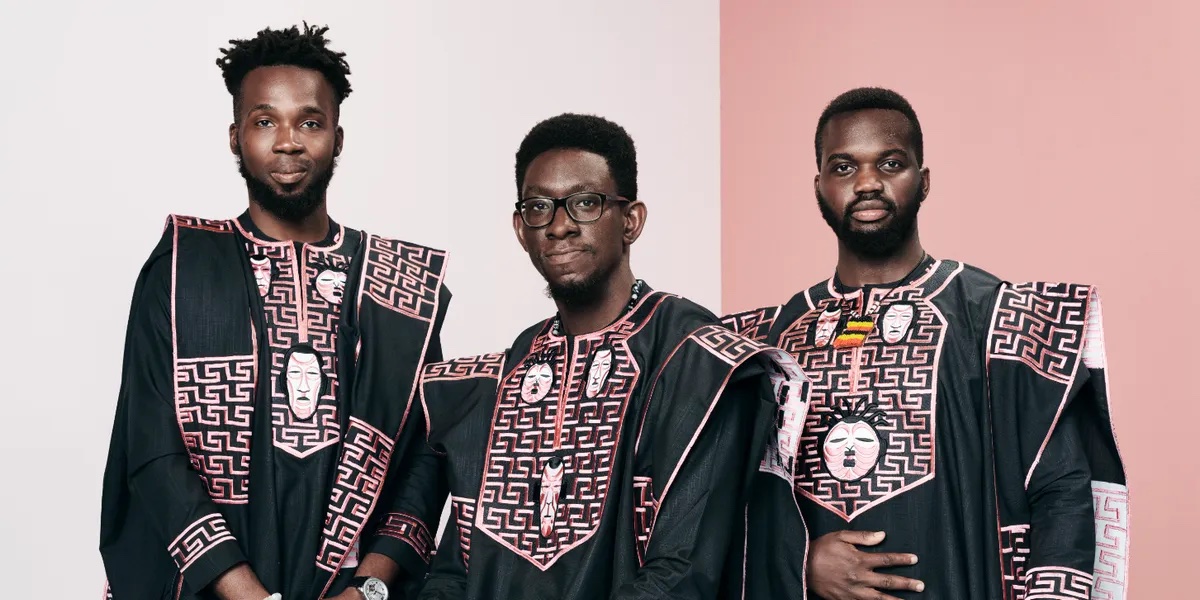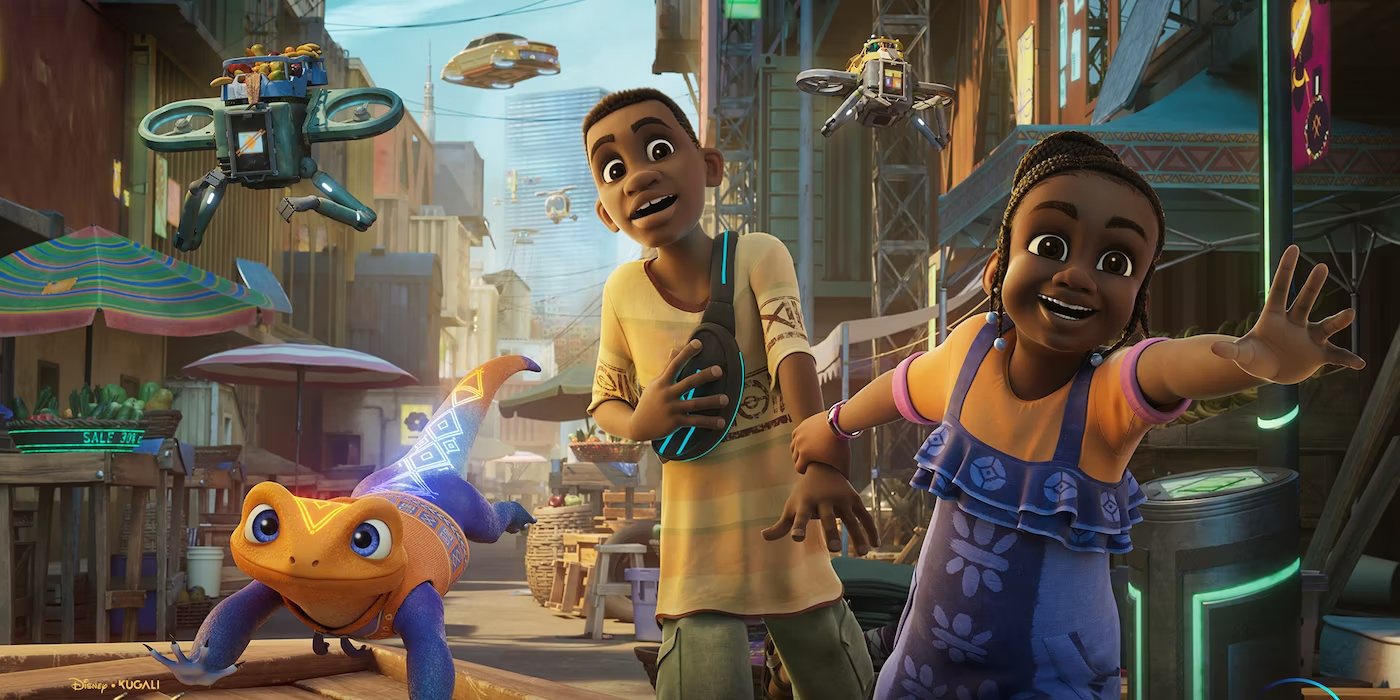Animated series Iwájú is a unique and original coming-of-age story set in a futuristic Lagos, Nigeria. Tola, a young girl from the wealthy island and her best friend, Kole, a self-taught tech expert, discover the secrets and dangers hidden in their different worlds. Translated as “the future” in the Yoruba language, Iwájú explores themes of inequality and class divide, issues affecting everyday life in Nigeria. It’s a production with a rich visual tapestry that has been brought to life by CInesite, created by Walt Disney Animation Studios and Pan-African Kugali Entertainment for Disney+. The 6-episode series features the voices of Simisola Gbadamosi (Tola), Dayo Okeniyi (Tunde), Femi Branch (Bode), Siji Soetan (Kole) and Weruche Opia (Otin).
In this three-part case study, we will explore a range of themes, including the Disney/Kugali collaboration, building the Iwájú world and the importance of reflecting authentic Nigerian culture.
The journey for Cinesite began in 2021, when we were awarded work; the main production hub was in Montreal, with global support from the Vancouver and London studios. As an external studio to be entrusted with delivering a Walt Disney Studios production, one which was also Kugali’s first animated project, it was a tremendous honour for the team. From the start, a close-knit relationship was formed between Cinesite, Disney and Kugali.

From Kugali, Iwájú was directed by Olufikayo “Ziki” Adeola, and production designed by Hamid Ibrahim with cultural consutlancy from Toluwalakin ”Tolu” Olowofoyeko. Disney Animation’s production visual effects supervisor was Marlon West, Disney’s director of photography and layout was Rob Dressel and producer Christina Chen. Key contributions from Cinesite include VFX supervisor Ellen Poon, producer Joel MacDonald, animation director Jason Ryan and a large extended team.
Kugali Media, founded by Iwájú director Ziki Adeola, is dedicated to creating stories based around new, untold and authentic African voices. The company came to the attention of the world-wide creative media through its work in anthologising comic and graphic novel content from creators across the African continent. In an interview with the BBC in 2019, the Kugali team laid down a challenge to Disney which was seen by Disney Animation’s chief creative officer, Jennifer Lee. She followed up with the team to discuss a potential collaboration and that’s where Iwájú was formed.
How Kugali & Disney Got Together How Kugali & Disney Got Together
Iwájú is an original story written and created as a collaboration between Kugali and Disney. The Kugali team created the idea which they pitched to Disney, who mentored, fostered and offered its valuable insight in developing the production. When Cinesite joined the team we were presented with a script, storyboards and detailed art and concept designs created by both companies. From that point, Cinesite developed layouts and asset builds for all environments, characters and props, building the world and bringing to life everything within it, before lighting, compositing and adding the final series look.
Disney provided a rough colour script to Cinesite, who brought in our own art director Christophe Vacher to complete the colour keys, working in close collaboration with Disney’s DP and head of layout Rob Dressel. Colour keys are vital in establishing the look and colour of every animated production, a series of background paintings and colours which every department refers to. They provide information about colour values and saturation which inform lighting and help set the mood.

Kugali’s comic book legacy is a clear influence in the look of the series, particularly seen in its action sequences where there are key graphic stand-out moments. However, with Disney’s input, Cinesite has retained the sophisticated, polished quality of a Disney production; these combined aesthetics create an elevated and rich visual tapestry. It’s an inspiring combination which we will continue to explore in this three-part case study.
In the series, 10-year-old Tola is gifted Otin by her father, a cute pet lizard which she is unimpressed to receive. Soon after, she is kidnapped on the mainland by Bode. Tola’s friend, young technical genius Kole, along with her father Tunde, unite in their efforts to find and rescue her. Otin’s secret ability to transform and protect Tola is finally revealed in an exciting climactic battle sequence.
Disney Animation artistic director and head of animation Malcon Pierce designed the characters alongside Kugali’s Hamid Ibrahim. Their initial blueprints, drawings and expression sheets were shared with Cinesite who carefully recreated each character digitally. In a collaborative process, Malcon returned draw-overs using SyncSketch and each model was gradually refined. Technical face set-ups were created and the team sculpted blend shapes and expressions onto the controls which allowed the animators to create the emotion and expression needed for each shot.
Iwájú’s protagonist, Tola, is struggling to find her place in the world, having grown up privileged on Lagos’ affluent island, but she is a positive and optimistic person. By contrast, Kole, who has grown up poor on the mainland, is filled with worry about his job security and the wellbeing of his family. His worry is revealed through the tension he carries in his shoulders, as well as his arm and hand movements.

The animators recorded themselves performing these scenes as reference, in order that the subtle contrasts between the children’s physical bearing transferred into their naturalistic performances.
Villain Bode is a huge character and personality but Tola, who has grown up without a sense of danger, is entirely unafraid of him. As a result, interactions between the two are often amusing, with the charming Tola unintimidated by his size and position. The animators communicated a convincing sense of Bode’s power through the way he speaks, moves and behaves. He is a powerful villain because the audience understands where he has come from and why he feels righteous, even if his beliefs are very wrong.
Otin, the small lizard-formed AI unit, was one of the more challenging characters to create. This was primarily due to her ability to transform from a benign, fleshy, hoodie-wearing animal into Ija mode – a 3-metre-long fighting robot. The transformation and scale changes were handled in a carefully choreographed series of graphic cutaways, showing close-up details of her metamorphosis; eyes turning red, armour plates forming and tail growing and splitting into four electrodes.
Otin attempts and fails several times before finally achieving her spectacular transformation. Tola and Kole also change throughout the series, learning more about each other’s perspectives and worlds. Iwájú is a tale of adventurous spirit and never giving up, which was a joy to create.
In the next part of this case study, we will explore how the Iwájú world was created before the final part, where we explore the importance of authentically portraying Nigerian culture.
All images and clips from Iwájú © Disney.
